
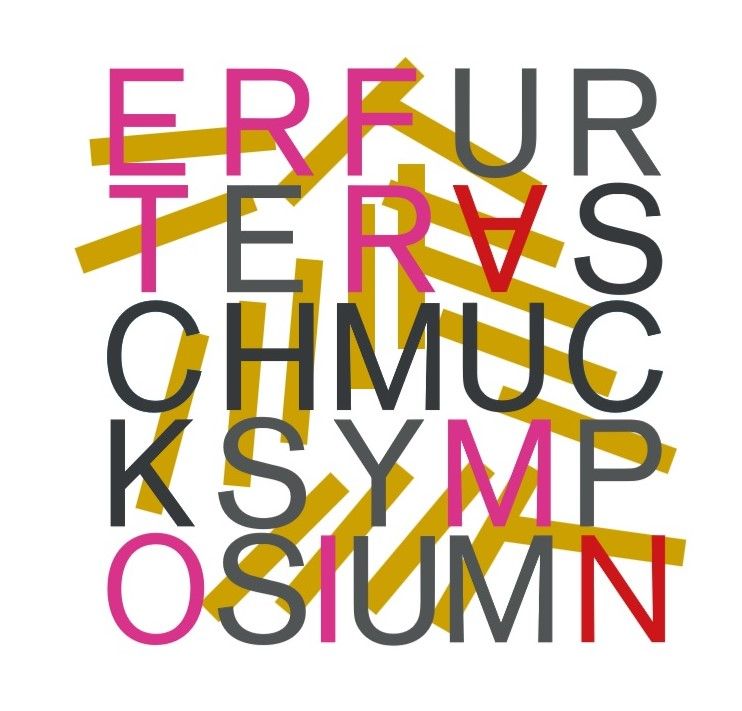
ECKDATEN / BASIC DATA
16. Erfurter Schmucksymposium in den Künstlerwerkstätten der Stadt Erfurt
Jewellery Symposium at the artist studios of the city of Erfurt
26. August bis 10. September 2017
Ausstellung Erfurter Schmucksymposium in der Galerie Waidspeicher Erfurt
Exhibition of the Symposium results at the Galerie Waidspeicher Erfurt
10. September bis 29. Oktober 2017
RE/FORMATION
THEMA DES SYMPOSIUMS 2017 – RE/FORMATION
Mit dem Begriff der Reformation verbindet man in unserem Kulturkreis zunächst die nun bald 500 Jahre währende, kirchliche Erneuerungsbewegung unter Martin Luther und anderen „Reformatoren“, die zwischen 1517 bis 1648 zur Spaltung des westlichen Christentums in verschiedene Konfessionen führte.
Aus anfänglich theologischen Reformgedanken sind neben der Idee eines freien, persönlichen Glaubens, also eines spirituellen Einzelnen in einem übergeordnetem Ganzen, auch gesamtgesellschaftliche Konsequenzen erwachsen. Diese Form der Reformation ist nicht mehr festzumachen an religiösen oder historischen Themen, sie steht allgemein für Erneuerung, Neuordnung, im üblichen Falle eine Rückbesinnung auf Bewährtes, im optimalen vielleicht sogar vorübergehend Sinnhaftes. Reformation ist also ein lebendiger Teil im politischen und ökonomischen Diskurs unserer Gesellschaft und hat nicht zuletzt auch einen großen Einfluss
auf die Kunst.
RE/FORMATION bedeutet also Wiederherstellung und Erneuerung. Ist die heutige Welt bereit für eine Erneuerung? Gerade in herausfordernden Zeiten müssen wir die guten Zeiten für die Kunst sehen und an einem sehr guten internationalen Format, wie dem ERFURTER SCHMUCKSYMPOSIUM, festhalten. Unter dem Begriff RE/FORMATION verstehen wir die Fähigkeit, die Inhalte immer wieder zu überprüfen, zu erweitern und den aktuellen Möglichkeiten und Plattformen anzupassen. Luthers Grundgedanke, die Kirche als Institution zu entstauben und den Glauben von falschen Lehren und überflüssigen Riten zu befreien, kann im weitesten Sinne auch auf die künstlerische Arbeit übertragen werden und auf das Symposium selbst.
Die Festplatte neu formatieren?
Für das 16. ERFURTER SCHMUCKSYMPOSIUM gilt ebenso die ganz formale bzw. persönliche Interpretation des Reformgedankens und dessen Bedeutung in aktuellen Themen aus Politik, Gesellschaft, Religion etc. Die Teilnehmer werden die vielfältigen, oft erstaunlich aktuellen Facetten des Begriffes RE/FORMATION ausloten, definieren, dokumentieren und die Ergebnisse auf zeitgemäße Art präsentieren.
Das Jubiläum Luther 2017 – 500 Jahre Reformation, bei dem viele internationale Gäste erwartet werden, bietet dem ERURTER SCHMUCKSYMPOSIUM die ideale Plattform für Arbeit und Präsentation der Schmuckkunst außerhalb des gewohnten Rahmens.
TOPIC OF THE 2017 SYMPOSIUM – RE/FORMATION
In our cultural circle the term of “reformation” is closely related to the now close to 500 year old ecclesiastical renewal movement headed by Martin Luther and other “reformers”. It resulted in the division of Western christianity in different confessions between 1517 to 1648.
Starting from the notion of theological reform like the idea of a free, personal faith as a spiritual individual in a greater picture, there were consequences on the whole of society. This form of reformation is not tied to religious or historical topics, it stands for renewal, rearrangement, in the usual case a recollection of the proven, in the ideal case even something transitory purposeful. Reformation is a vital part in the political and economical discourse in our society and has also a great influence on the arts.
RE/FORMATION means restoration and renewal. Is the world of today prepared for a renewal? Particularly in challenging times we have to see good opportunities for the arts and hold on to a good international format like the ERFURT JEWELLERYSYMPOSIUM.
We understand the term RE/FORMATION as the ability to reexamine the content, to expand and to adapt to the current possibilities and platforms. Luthers fundamental idea, to dust off the church as an institution and to free faith from wrong teachings and superficial rites. In the broadest sense this can be applied to the artistic work as well as the symposium itself.
Reformatting the hard-drive?
The 16th ERFURT JEWELLERYSYMPOSIUM stands for the formal as well as personal interpretation of the reforming-idea and
The Luther anniversary of 2017 – 500 years of reformation – will attract a great number of visitors and provide the ideal platform for the ERFURT JEWELLERYSYMPOSIUM to work on and to present the jewellery arts apart from the usual avenue.
TEILNEHMER / PARTICIPANTS
Eun Mi Chun, Südkorea/South Korea
Bettina Dittlmann, Deutschland/Germany
Bernhard Elsässer, Deutschland/Germany
Anne Lengnink, Deutschland/Germany
Maria Militsi, Griechenland/Großbritannien/Greece/UK
Selen Özus, Türkei/Turkey
Mandy Rasch, Deutschland/Germany
Karola Torkos, Deutschland/Germany
Martin Verner, Tschechien/Czechia
Monique Weinert, Deutschland/Germany
RESÜMEE / RÉSUMÉ
Zitate aus dem Katalogtext von Prof. Dr. Kai Uwe Schierz, Direktor der Kunstmuseen Erfurt
Quotations from the catalog text by Prof. Dr. Kai Uwe Schierz, Director of the Art Museums Erfurt
Im Spätsommer 2017 trafen sich, eingeladen von den Initiatoren des Schmucksymposiums und Mitgliedern der Projektgruppe HEIKE GRUBER, MANDY RASCH und KAROLA TORKOS, wieder zehn internationale Künstler*innen in den Künstlerwerkstätten der Stadt Erfurt, um zwei Wochen lang im Erfurter Schmucksymposium gemeinsam zum Thema RE/FORMATION zu arbeiten. Selten geht es dabei um die Fertigstellung schmuckkünstlerischer Werkstücke, sondern zumeist um die Entwicklung von Arbeitsproben und Skizzen, um das Erproben von technischer Innovation, die Erschließung neuer Werkstoffe und um interdisziplinäre Erweiterungen des jeweiligen Arbeitsgebietes. Die Arbeitsproben und Projekte wurden noch während des Symposiums ausgewählt und gemeinsam für die Präsentation vorbereitet. […]
Neun [Künstler*innen] haben Skizzen und Schmuckentwürfe hergestellt oder vorhandene Objekte re-formiert – von Fundobjekten bis zu mitgebrachten Werkstücken. Die Fundobjekte überwogen jedoch am Schluss und zeigen die Fähigkeit aller Teilnehmer*innen, spontan und kreativ auf zufällige Wahrnehmungen und aktuelle Erlebnisse zu reagieren, darauf gestalterisch, also formend, zu antworten. […] Eine weitere Teilnehmerin begleitete die neun anderen mit der Kamera und dem Notizblock, um vermittels Fotos und Berichten Eindrücke aus dem 16. Erfurter Schmucksymposium in einem Internetblog zu publizieren.
Die Ausstellung im Erdgeschoss der Galerie Waidspeicher zeigt[e] sich als strenge Formation von zehn industriell gefertigten Regalen, die den Raum diagonal [durchzog]. In einem kuratorischen Findungsprozess entschied man sich für offene Regale anstatt Vitrinen, weil der Werkstattcharakter des Symposiums, das Prozessuale der Arbeitssituation auch in der Präsentation der Arbeitsproben zum Ausdruck kommen sollte. Prägend sollte auch jene Offenheit wirken, mit der die Teilnehmer*innen des Symposiums sich begegnet sind und nun den Besuchern der Ausstellung begegnen wollen.
In late summer 2017, invited by Jewellery Symposium founders and Project Group members Heike Gruber, Mandy Rasch and Karola Torkos, ten international artists once again met in the Artists Studios of Erfurt, to spend two weeks working together in the Erfurt Jewellery Symposium. This is rarely about completing pieces of artistic jewellery, but rather about creating draft designs and test pieces, trying out innovative techniques, developing new materials and expanding artistic fields of activity through interdisciplinary work. Artists selected test pieces and projects during the symposium and worked together to prepare them for presentation. […]
Nine [artists] produced drafts or designs for jewellery or re-formed existing items – from items they had found to pieces of work they had brought with them. It was the found items that dominated in the end, showing the ability of all participants to respond spontaneously and creatively in terms of form and design to chance perceptions and immediate experience. […] One other participant followed the nine others with a camera and a notebook, publishing photos and reports in a blog giving her impressions of the 16th Erfurt Jewellery Symposium. The exhibition on the ground floor of the Gallery Waidspeicher [was] presented in a strict formation of ten industrial-style shelves set diagonally across the room. Shelves were selected rather than display cases as the exhibition was curated, with a view to ensuring that the test pieces were presented in such a way as to bring out the workshop nature of the symposium and the working processes involved. The exhibition [was] intended to reflect the openness with which symposium participants came together and with which visitors encounter the exhibition.
BLOG ZUM 16. SCHMUCKSYMPOSIUM / BLOG TO THE JEWELLERY SYMPOSIUM
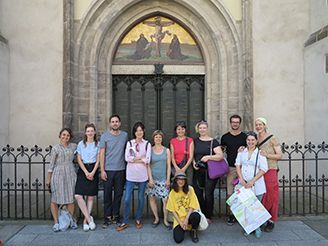
KÜNSTLER*INNEN UND PROJEKTE / ARTISTS AND PROJECTS
(Zitate aus dem Katalogtext von Prof. Dr. Kai Uwe Schierz, Direktor der Kunstmuseen Erfurt
Quotations from the catalog text by Prof. Dr. Kai Uwe Schierz, Director of the Art Museums Erfurt)
EUNMI CHUN (Südkorea) […] ist eine bedächtige Schaffende, die bestimmte Materialkombinationen und Formungen über längere Zeiträume hinweg entwickelt und variiert. […] Auch hat sie einen besonderen Sinn für Materialien und deren Kombinationen. […] In ihrer minimalistischen Präsentation variiert sie die ihr vertraute Metaphorik von Haut und Flügeln – zwei unvereinbare Stoffe, wie es scheint […]. Ihre aus vielen Einzelelementen aufgebauten Flügelformen sind deshalb […] Metaphern des Unmöglichen […] [,] aber genauso der Sehnsucht, die in der Lage ist, das Unmögliche für einige Augenblicke möglich erscheinen zu lassen. Ihre Broschen verleihen den Trägerinnen und Trägern Flügel, in mehrfacher Hinsicht.
EUNMI CHUN (South Korea) […] is a thoughtful creator, who develops and adapts specific combinations of materials and forms over long periods of time. […] She too has an acute sense of materials and how to combine them. […] In her minimalistic presentation, she varies her familiar imagery of skin and wings – two apparently incompatible materials […]. The wing shapes she constructs from many individual elements are therefore also metaphors for the impossible […] [, but] they also express the longing for the impossible to seem possible, just for a moment. In many ways, her broaches lend their wearers wings.

BETTINA DITTLMANN (Deutschland) […] setzt ganz auf die poetische Wirkung des Zufalls als formbildende Ursache. […] In zufallsgenerierten Formprozessen spielen Findungen am Anfang die wichtigste Rolle. Aber auch die intuitive Antwort auf eine Findung – sei es eine Taubenfeder oder eine Metallschale aus den 1970er Jahren […]. Das Flüchtige und Fragile kann durchaus auch eine metallische Materialgrundlage haben: zum Beispiel [bildeten] winzige Eisenspäne, mit der Feile von größeren Objekten gewonnen […], in Schalen versammelt und durch starke Magneten […] gerichtet bzw. re-formiert […] symmetrische Formationen, kleinräumig und verletzlich wie lebendige Flechten oder Blüten. […]
BETTINA DITTLMANN (Germany) […] is wholly focused on the poetic effect of chance as a creative force. […] In random processes of formation, found objects play the most important role to begin with. But so does the intuitive response to a find – whether it is a pigeon feather or a metal bowl from the 1970s […]. The ephemeral and the fragile can certainly have a metallic material as their basis: for instance, tiny iron shavings, obtained from larger objects with a file […], collected in bowls and organised and re-formed using powerful magnets […], the metal filings created symmetrical forms, small-scale and vulnerable, just like living lichen or blossoms. […]
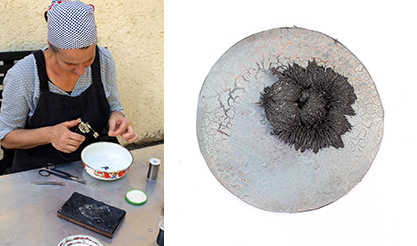
BERNHARD ELSÄSSER
(Deutschland) […] zeigt sich als Tüftler und Spezialist für das besondere Detail. Experimente mit dem Emaillieren von metallischen Fingerhüten führten ihn an die Grenzen der Materialbelastung […]. Dafür hielt das vorgefertigte Rohmaterial aus dem modernen Modelleisenbahnersortiment seinen Ansprüchen und Beanspruchungen stand. Die Elemente für zwei Brücken re-formierte er zu großformatigen Broschen, deren konstruktive Form besticht, wobei auch die Oberflächen faszinieren. […] Überall [...] fand er [...] interessante Strukturen und formte sie mittels klassischer Frottagetechnik […] ab, wobei er einige mit Nadeln versah, um fragile, papierleichte wie temporäre Schmuckstücke […] daraus zu kreieren.
BERNHARD ELSÄSSER (Germany) […] is a self-declared inventor, and a specialist in attention to detail. Experimenting with enamelling metal thimbles led him to explore the limits of the stresses to which materials can be subjected […]. In this context, the prefabricated raw material from a modern model railway range coped well with his requirements and demands. He re-formed the parts of two bridges into large-scale broaches that had both a beguiling construction and fascinating surfaces. […] He [....] found interesting structures everywhere [...] and took impressions of them using a traditional rubbing technique […], adding pins to some of them to create fragile, paper-light and transitory pieces of jewellery […].
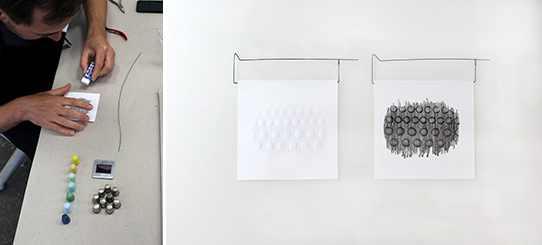
ANNE LENGNINK (Deutschland) ist […] eine Forscherin, die an innovativen Methoden, Materialien und Verarbeitungsmöglichkeiten ebenso interessiert ist wie an starken sinnlichen Eindrücken, und dabei Gattungsgrenzen überschreitet. […] Abformungen von Luftballons mit fließender Biskuitporzellanmasse, deren Hohlkörper anschließend zu brennen waren – das ergibt ein klassisches Trial and Error-Szenario, in dem ebenso viel schief gehen kann wie gelingen. […] Das Verwandeln von Alltagsobjekten in Formen, die Staunen hervorrufen, war auch ihre Methode beim Entwerfen eines Colliers: Hierfür wurde Ware vom Secondhandmarkt geschnitten, thermisch verformt und mit Schnüren verbunden. […]
ANNE LENGNINK (Germany) […] is a researcher who is equally interested in innovative methods, materials and processing techniques and in creating a powerful impact on the senses, and this leads her to transcend the boundaries between genres. […] Balloons moulded from smooth biscuit porcelain, whose hollow forms were then fired – this sets up a classic trial-and-error scenario, in the course of which as much can go wrong as go right. […] The transformation of everyday objects into forms that provoke astonishment was also the methodology she used for designing a necklace: she cut and thermally reshaped articles from a second-hand market and linked them together with string. […]
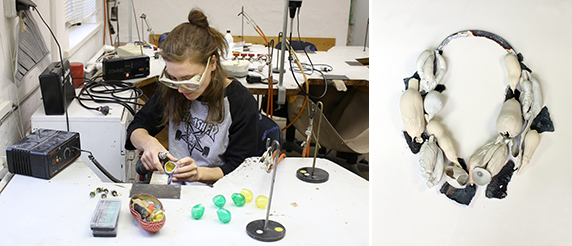
MARIA MILITSI (Griechenland/Großbritannien) […] betätigt sich als Sammlerin und Interpretin alltäglicher Dinge, die sie jedoch zu Zeichen von bestimmten, [persönlichen] Erfahrungen re-formiert. […] So inspirierten sie die 500 Jahre […] [Thesenanschlag] zu 500 selbstbebilderten Buttons […] [, deren Motive] von bunten Verpackungspapieren […] aus dem Müll […] [stammen]. [Sie ist] daran interessiert, Dinge und Bedeutungen aus ihren gewohnten Kontexten zu entnehmen und aufeinander prallen zu lassen, so dass die Reibung kreative Energien freisetzt. Auf dem Flohmarkt in Erfurt fand sie kleine Keramikfiguren, […] bäuerlich im Stil […], die jeweils zwei Gefäße geschultert haben. Die vorhandenen Schnüre ersetzte sie durch Gold- oder Silberketten – ein minimaler Eingriff, der unvermittelt Wertefragen provoziert […].
MARIA MILITSI (Greece/UK) […] is a collector and interpreter of everyday objects, which she re-forms into symbols of specific personal experience. […] And the 500th anniversary of Luther’s posting of his theses inspired her to create 500 button badges with her own designs […] [, which] came from colourful packaging that she found in the rubbish. [She] is interested in taking objects and meanings out of their usual context and allowing them to collide, and the resulting friction to release creative energy. She found small ceramic figures at the flea market in Erfurt, […] naive and rustic in style, […] each carrying two vessels on their shoulders. She replaced the cords with gold and silver chains – a minimal intervention, but an abrupt provocation of questions about values […].
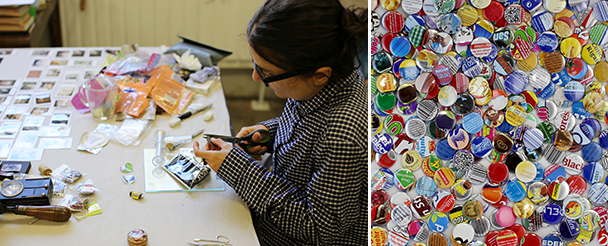
SELEN ÖZUS (Türkei) […] Ihre Arbeit im Symposium ist […] eine Art von Trauerarbeit: Sie hat kleine Pflanzen vom Wegesrand gesammelt, sie zwischen Buchseiten gepresst, in feuchte Modelliermasse gedrückt, so dass wir nun ihre feingliedrigen Abdrücke sehen können. Und sie hat einige von ihnen in mächtige Anhänger und Broschen aus Modelliermasse eingefügt und mit Gaze verschlossen. Wie durch ein filigranes Gitter hindurch schauen wir nun auf die eingeschlossenen winzigen (getrockneten) Blüten inmitten großer, reinweißer Schmuckobjekte. Sie sind dort jedoch nicht nur eingeschlossen, sondern werden, wie kostbare Erinnerungen, auch geschützt und bewahrt: petits souvenirs de Erfurt.
SELEN ÖZUS
(Turkey) […] However, her work in the Symposium is a kind of grieving: she gathered small plants from the wayside, pressed them between the pages of books, and then pressed them into damp modelling clay to enable us to see the slender impressions they left behind. And she inserted some of them into chunky pendants and broaches made from modelling clay and set them behind gauze. We seem to look through a filigree lattice at the tiny enclosed (dried) blossoms in the centre of large, pure white pieces of jewellery. Yet they are not only enclosed there but are preserved and protected, like precious memories: little souvenirs of Erfurt.
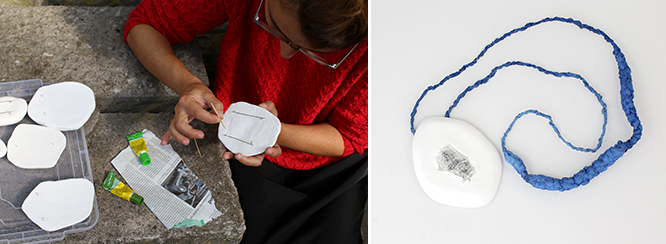
MANDY RASCH (Deutschland) wurde […] auf einem Schrottplatz fündig. Drei alte Benzinkanister […] ließ sie […] von der Schrottpresse platt drücken. Nun liegen sie […] nicht nur wie Metallbroschen für Riesen im Regal […], sie hat für jedes Objekt auch einen rechteckigen „Sticker“ emailliert, der den vorherrschenden Farbton der Oberfläche aufnimmt und darauf mit einer ästhetischen Intervention antwortet. […] Ein rostender, verbeulter Korb aus Metallgewebe […], umgestülpt und die Fehlstelle mit einem emaillierten Metallnetz „geflickt“, kann so zu einem kleinen Berg mit glänzendem Topping mutieren. Upcycling […]: Die Künstlerin kombiniert unedle Materialien […] mit tradierten Schmuckmaterialien und -verfahren und formiert sie auf diese Weise neu, […] veredelt sie zu „schönen Dingen“ […]. […]
MANDY RASCH (Germany) found her materials […] at a scrap yard. She collected three old petrol cans […] and […] had them crushed flat. Now they lie on the […] shelf […] not just like giant metal broaches – she has also enamelled a rectangular „sticker“ on each that picks up the predominant colour of the surface and is an aesthetic response to it. […] A battered, rusty, metal mesh basket […], upside down and with its defects patched up with enamelled metal netting, mutates into a kind of little mountain with a shining peak. Upcycling […]: the artist combines commonplace materials […] with traditional jewellery materials and processes and in this way gives them new form, […] elevates them to the status of “beautiful things” […]. […]
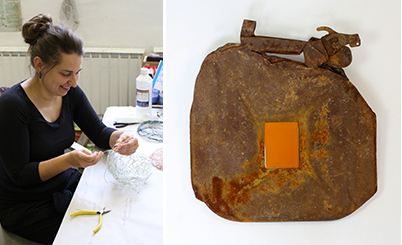
[…]
KAROLA TORKOS (Deutschland) […] fragte sich, ob man die vertrockneten Filzstifte, die ihre Tochter wegwerfen wollte, […] nicht recyclen [könne] […]. […] Karola Torkos […] schenkte [den Filzstiften] ein zweites Leben […] [–] zerlegt in ihre Einzelteile und neu kombiniert: Re-Formation als Re-Arrangement. So entstand beispielsweise aus den Farbfilzen durch Aneinanderreihen und Auffädeln ein Kunststoff-Collier, dessen Farben im Spektrum des Regenbogens an den Rändern miteinander verschmelzen – ein kontinuierlicher Prozess […]. Aus einfachen Alltagsgegenständen und unedlen Materialien spielerisch etwas kreieren, das unsere Aufmerksamkeit fesselt, zum Werkstück wird und schließlich zum Wertstück und Schmuckstück, ist die hohe Schule kreativer Weltbegegnung […]. (plus die Abbildung der Kette aus den Plastik-Teilen)
[…]
KAROLA TORKOS (Germany) […] [asked herself, if you could recycle the felt-tip pens that dried up and that her daughter wanted to throw away]. […] Karola Torkos […] giving [the felt-tip pens] a second lease of life […] [–] by taking them apart and recombining the individual components: re-formation as re-arrangement. So, for example, she threaded the inserts together to create a plastic necklace, whose colours run into each other at the edges in a rainbow spectrum – a continuous process […]. Creating something playful, something that captures our attention, out of simple everyday objects and commonplace materials, turning it into a piece of work and finally into a piece of jewellery, is to encounter the world at the highest level of creativity […].
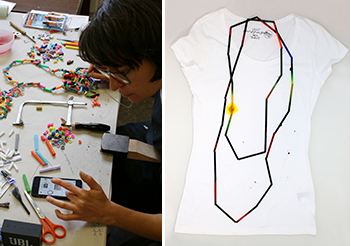
MARTIN VERNER (Tschechien) […] orientierte sich an dem Tschechen Jan Hus, der 100 Jahre vor Luther ähnliche Reformen wollte, dafür aber noch als Ketzer verurteilt und verbrannt wurde […]. Das Brennen und die Flamme – auch Flamme des Geistes – waren deshalb schnell als willkommene Sujets und Methoden der Bearbeitung im Blick. Thermische Verformungen von Kunststoff-Streifen führen vor, was re-formieren beispielhaft heißen kann. Aus starr wird beweglich, […], aber nur für kurze Zeit [, dann] verfestigt sich das gerade noch Bewegliche schon wieder. […] [Angelehnt] an […] [die] Graffiti-Jugendkultur […] hat er den re-formierten Kunststoff-Streifen feurige Farben aus der Spraydose verordnet. Der Flammenring ist der Gipfel seiner Re-Formation. […]
MARTIN VERNER
(Czechia) […] was geared to the Czech Jan Hus, who pursued reforms similar to those sought by Luther 100 years previously, but was convicted of heresy and burned […]. He therefore had in mind burning and flames – including the flame of the spirit – from a very early stage as opportune subjects and ways of working. He used thermal distortion of strips of plastic to exemplify re-formation. The rigid becomes supple, […] but only for a short time [, afterwards], what has just been supple solidifies again. […] Taking […] the global youth graffiti culture […] as his starting point, he assigned the re-formed plastic strips fiery colours from spray cans. The Ring of Fire is the peak of his re-formation. […]
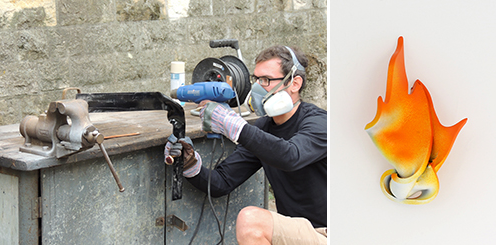
[…]
MONIQUE WEINERT
(Deutschland) […] [stellte] täglich ihre Erlebnisse und Eindrücke während des 15-tägigen Symposiums in Texten und Bildern [dar]. Bereits am ersten Werkstatttag schrieb sie auf dem Blog […] über einen magischen Ort im Erfurter Norden [,] […] beobachtete fasziniert, welch Quelle der Inspiration sich in den versteckten Künstlerwerkstätten entfachte. Wie neun [Künstler*innen] draufloslegten mit den verschiedensten Materialien und Strategien. […] In der abschließenden Ausstellung bespielt die schreibende Künstlerin […] ein weißes Regal mit ihren Ergebnissen, ihrem Prozess. Sie begreift es als „Echo“ ihrer Arbeit […] [in den sozialen Medien] und füllt es mit Foto-Mobile und Textschnipseln aus den vergangenen aufregenden Tagen.
[…]
MONIQUE WEINERT (Germany) […] was asked […] to provide a daily record of her experiences and impressions of the 15-day Symposium in words and pictures. On the very first day of the workshop, she wrote about a magical place in the north of Erfurt on the blog […] [, she] watched with fascination as sources of inspiration were sparked in the tucked-away artists’ workshops. How nine artists got stuck in with the most varied materials and approaches. […] In the closing exhibition the artistic writer presents her work […] on a white shelf showcasing her results and her process. She conceives of her work on the […] [Social Media] as an “echo”, and has filled it with photo mobiles and snippets of text from the exciting days gone by.

AUSSTELLUNG / EXHIBITION
10.09. - 29.10.2017

KATALOG / CATALOGUE
zum 16. Erfurter Schmucksymposium
verfügbar / available

Die Themenreihe ERFURTER SCHMUCKSYMPOSIUM ist ein Projekt des Verbandes Bildender Künstler Thüringen